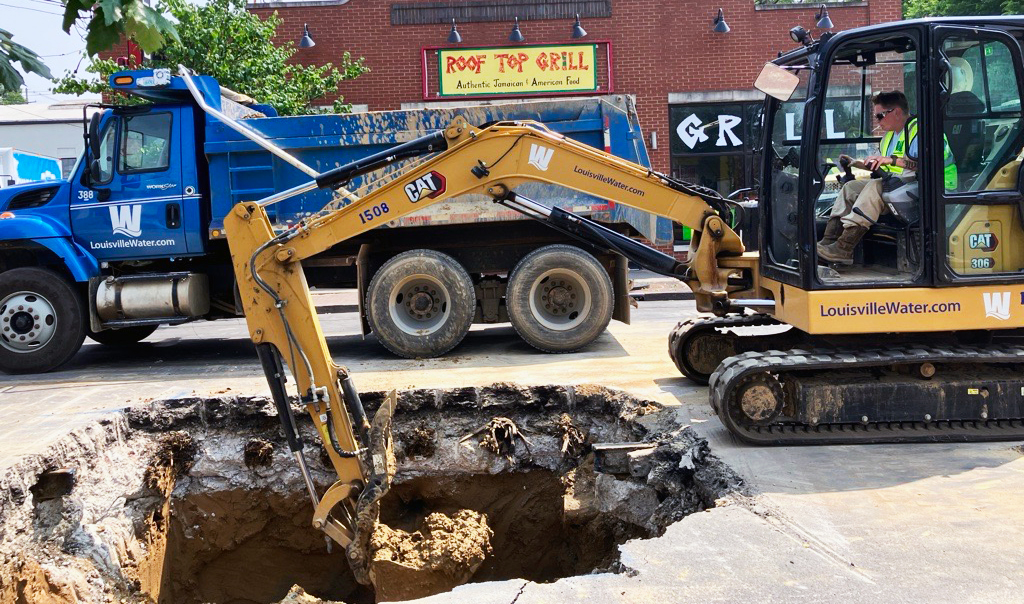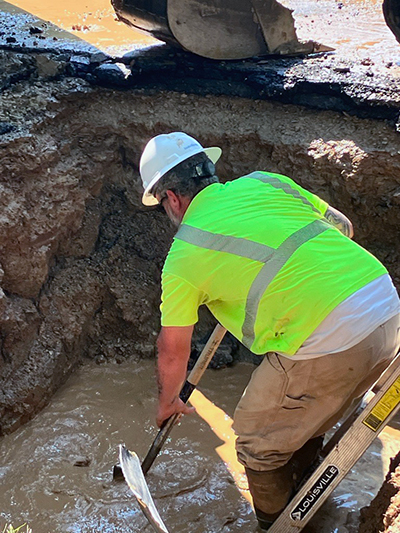Louisville Water manages over 4,300 miles of water main throughout its service area. These pipes deliver safe, high-quality drinking water to nearly one million people every day.

Some of these pipes date back to the late 1800s. Like a car or an A/C unit, a water main has a typical life span or “useful life”. For water mains, it’s typically 65 to 100 years depending on the pipe material.
Why do water mains break?
Water mains break for several reasons. It can be due to external factors like temperature or pressure changes, soil corrosion, or underground work impacting the pipe. The age of the pipe and material are also factors.
What to expect when a main break happens?
Main breaks can cause reduced water pressure or temporary loss of service. Water may also surface during a main break.
If a water main break impacts your service, Louisville Water aims to inform customers as promptly as possible, typically through a door hanger placed on the front door of the property or a direct phone call. Unless notified by a Louisville Water employee, your water is safe to drink during a water main break.
Usually, crews can fix a break and restore water service within five to eight hours, but this could take longer under extenuating circumstances.
How does Louisville Water respond?
Our front line of defense is the radio room, where dispatchers gather any initial information. How large is the leak? Are customers impacted? Is the road blocked? How urgent is the situation? The next step is controlling the water flow.
 Control Water Flow
Control Water Flow
Our emergency turners are the first on the scene to verify the break and manage the flow using the distribution system valves. We may partially close the valves or shut off the water completely to isolate the emergency.
Locate & Dig
The next step is marking other utility lines and bringing in heavy equipment to excavate the area. These digs can be tricky if gas, electric, or sewer lines are around the break.
Inspect & Repair
Once the crew reaches the main, they reroute the water to minimize service disruption by closing nearby valves. There’s typically two options to repair a main: a repair band, which is like a metal clamp; or completely replacing the damaged pipe.
Flush, Sample & Restore
Once they’ve repaired the pipe, the crew will flush the water lines. They’ll send a flushing report to Louisville Water’s treatment plant, signaling the water is ready to be tested. Once cleared by the water quality team, service is restored. If we ever ask you to follow a boil water advisory, here’s what to do: LouisvilleWater.com/BoilWaterAdvisory.
What are we doing to reduce the number of main breaks?
Louisville Water aims to have fewer than 15 main breaks per 100 miles of pipe per year, which is the standard for the American Water Works Association’s Partnership for Safe Water program. Currently, our five-year main break frequency is 13.8 breaks per 100 miles. To maintain this downward trend, Louisville Water has implemented preventive measures, including:
Cathodic Protection Program: About 20 years ago, Louisville Water launched an effort to guard certain water mains against corrosive soil by coating them with anodes, an oxidizing metal.
Leak Detection: Louisville Water has a leak detection specialist to detect underground leaks that may not surface. This person works with crews to help locate leaks before digging, saving time and water loss.
Main Replacement & Rehabilitation Program: This effort proactively addresses aging water infrastructure before it breaks. A formula helps determine whether it’s more cost-effective to repair or replace water mains, specifically smaller neighborhood pipes around 12 inches or less. The calculation considers factors like:
- Number of historical main breaks
- Soil conditions
- Proximity to critical infrastructure (schools, fire services, medical facilities)
- Number of impacted customers
- Repair vs. replacement costs
Not only do crews notice a smaller number of main breaks to address, but the numbers reflect that too. Since 2007, water main breaks have steadily declined by 30% in Louisville Water’s distribution system.
“We use a lot of data to try to determine where the biggest needs are and where our best investment is,” said David Mulloy, Louisville Water’s manager of infrastructure planning. “We don’t just go out and pick mains ‘at random.’ We really try to be smart and data-driven and financially responsible when we do these projects.”


